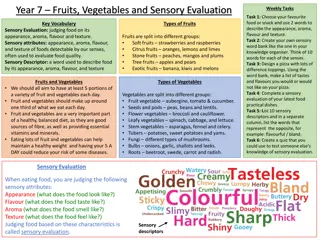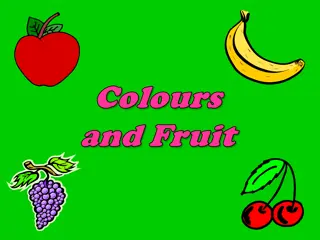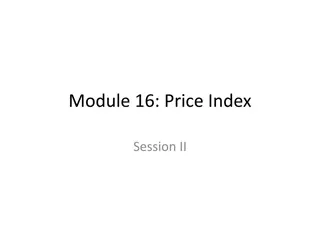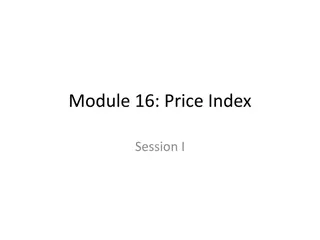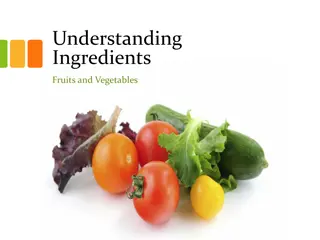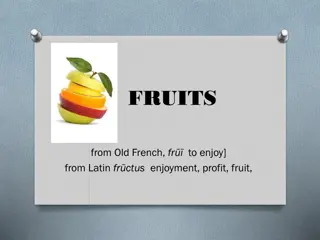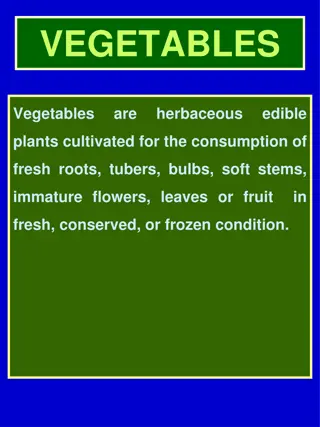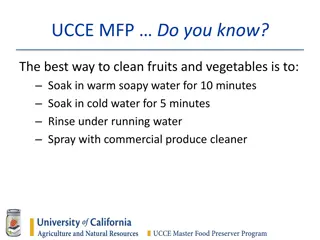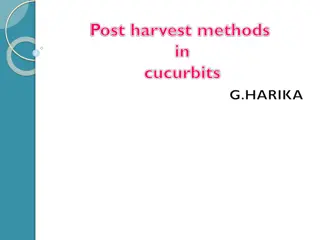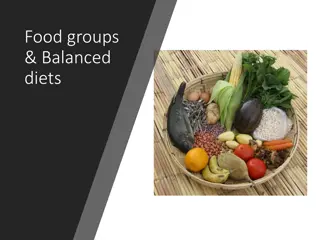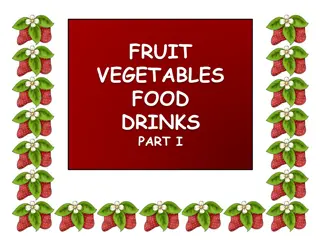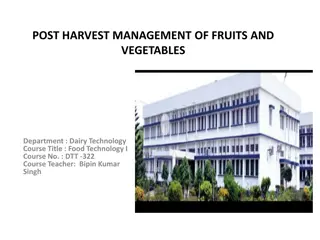Understanding Maturity Indices of Fruits and Vegetables
Maturity in fruits and vegetables is crucial for proper ripening, storage, and transportation. Picking produce at the right stage impacts flavor, quality, and shelf life. Harvesting too early or too late can result in issues like flavor loss, faster deterioration, and lower yields. Learn about the importance of physiological and horticultural maturity to ensure optimal quality and marketability of fruits and vegetables.
Download Presentation

Please find below an Image/Link to download the presentation.
The content on the website is provided AS IS for your information and personal use only. It may not be sold, licensed, or shared on other websites without obtaining consent from the author. Download presentation by click this link. If you encounter any issues during the download, it is possible that the publisher has removed the file from their server.
E N D
Presentation Transcript
Maturity indices of fruits and vegetables
MATURITY It is the stage of fully development of tissue of fruit and vegetables only after which it will ripen normally During the process of maturation the fruit receives a regular supply of food material from the plant When mature, the abscission or corky layer which forms at the stem end stops this inflow Afterwards, the fruit depend on its own reserves
In addition to this, typical flavour and characteristic colour also develop It has been determined that the stage of maturity at the time of picking influence the storage life and quality of fruit when picked immature like mango develop white patches or air pockets during ripening and lacking in normal brix acid ratio or sugar acid ratio, taste and flavor on the other hand if the fruits are harvested over mature or full ripe they are easy susceptible to microbial and physiological spoilage and their storage life is considerably reduce
Such fruits persist numerous problems during handling, storage and transportation Therefore, it is necessary or essential to pick up the fruits or vegetables at correct stage of maturity to facilitate proper ripening, distant transportation and maximum storage life The postharvest quality of the product is fixed at the harvest so proper harvesting is necessary We can have good harvest if we harvest at proper time as the development of the fruits is at later stage of development
Fruits harvested too early may lack flavor and may not ripen properly, deteriorate faster and have short shelf life while produce harvested too late may be fibrous or have very limited market life Yield may also be lower Therefore harvesting of fruits and vegetables at proper stage of maturity is of paramount importance for attaining desirable quality The maturity has been divided into two categories i.e. physiological maturity and horticultural maturity.
Horticultural maturity/Commercial maturity Stage of development when plant parts possess the necessary characteristics preferred by consumers Depends on the intended use e.g. papaya, jackfruit Physiological maturity Applies only to fruits and fruit vegetables End of development stage Ability to ripen normally after harvest for distant market and storage, o climateric fruits should be harvested at maturity before they are ripe i.e. before climateric rise o Non climateric fruits should be harvested at ripe stage
Importance of maturity indices Maturity indices = harvest indices Sensory and nutritional quality Adequate shelf life Facilitate marketing- standards Productivity
Too often we are on the side of shelf life at the expanse of good eating quality
Maturity indices Sign or indications of the readiness for harvest Basis for determining harvest date Two types of maturity indices i) Subjective: Qualitative Use the senses (color, size, shape, sound, firmness, juice content etc.) ii) Objective: Quantitative Are measurable indices (TSS, TA, Starch content, oil content, firmness, dry matter, Days after full bloom, heat degree day, respiration and ethylene production, production of volatiles etc.)
Types of indices i) Visual indices a) Size and shape: Maturity of fruits can be assessed by their final shape and size at the time of harvest. Fruit shape may be used in some instances to decide maturity. For example, the fullness of cheeks adjacent to pedicel may be used as a guide to maturity of mango Banana : angular shape changes to round
b) Colour: The loss of green color of many fruits is a valuable guide to maturity
ii) Physical indices a) Firmness: As fruit mature and ripen they soften by dissolution of the middle lamella of the cell walls. In many fruits such as apple, pear, peach, plum, guava, kinnow etc. firmness can be used to determine harvest maturity. Penetrometer measures the pressure necessary to force a plunger of specified size into the pulp of the fruit. Such pressure is measured in pounds and kilograms force.
b) Specific gravity: Specific gravity is the ratio of the density of a substance to the density of a reference substance. As fruit mature, their specific gravity increases. This parameter is rarely used in practice to determine when to harvest a crop It is used to grade crops into different maturities. To do this the fruit or vegetable is placed in a tank of water; those that float will be less mature that those that sink. In practice, the fruit or vegetable is weighed in air, then in pure water. The weight in air divided by the weight in water gives the specific gravity.
iii) Chemical Measurement The total soluble solids of the fruit can be measured with refractometer, which indicate the harvest maturity of fruits. Acidity is readily determined on a sample of extracted juice by titration with 0.1 N NaOH. TSS/TA is better to judge maturity as it gives the sugar acid blending of product a) Total Soluble Solids can be determined in a small sample of fruit juice using hand refractometer The refractometer measures the refractive index, which indicates how much a light beam will be slowed down when it passes through the fruit juice. The refractometer has different scales (0-32OB), (28-62OB) and (56-92OB) which can be read directly.
For large size fruits, these should be cut from stem to blossom end and to the centre of the fruit to account for variability in TSS from top to bottom and inside to outside of the fruit. The fruit tissues should be macerated thoroughly in pastle motor and then from the mescerated pulp the juice is extracted by passing through muslin cloth. A drop of juice is then put on the prism of the refractometer and TSS content can be read directly on the scale. However, in case of small fruits like grapes, the juice content can be extracted by simply pressing the whole fruit.
b) Titratable acidity: Titratable acidity (TA) can be determined by titrating a know volume of juice with 0.1N NaOH to end point The milliliters of NaOH needed are used to calculate the TA. The TA expressed as percent malic, citric or tartaric acid can be calculated as follows:
iv) Calculated indices: a) Calendar Date/Days after full bloom : Useful guide to harvest, where seasonal variation in climate is small This method works well when the blooming period is short period b) Heat Units: It has been found that a characteristics number of heat unit or degree-days is required to mature a crop under usually warm conditions It is based on the principle that growth of plant organ is directly proportional with ambient temperature
V) Physiological Method: Respiration rate: Particularly on climateric fruits can accurately pin point the most appropriate time of harvest as there is climateric rise in respiration Internal ethylene evolution: Like respiration rise climateric fruits also have ethylene peak Volatiles production: Apple: Ethyl-2-methyl butyrate Banana: Eugenol Grapefruit: Nootaketone Lemon: Citral Orange: Valencene
Maturity indices should be simple, easy to carry out Objective vs subjective indicators Related to quality Related to storage life Represents a progressive change with maturity Premits prediction of maturity from year to year inexpensive
Limitations of maturity indices uses Soil conditions, nutrition, irrigation Season , climate Position on the plant Pruning and other cultural practices and management practices varieties




